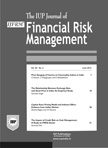|

Jun'15 |
Focus
In the first paper of this issue, “Price Gouging of Futures on Commodity Indices in
India”, the authors, G Naresh, S Thiyagarajan and S Mahalakshmi, note that market
participants in derivatives market will continue to make wild speculation because their only goal is to make profit, and the more artificial demand they create, the more commodity prices will rise artificially away from the levels justified by the market fundamentals.
|
|
|
Articles |
| |
Price Gouging of Futures on Commodity Indices in India
--G Naresh, S Thiyagarajan and S Mahalakshmi
Market participants in derivatives market will continue to make wild speculation because their only goal is to make profit, and the more artificial demand they create, the more commodity prices will rise artificially away from the levels justified by the market fundamentals. Hence, the price in the futures market is not based on actual supply and demand figures. The government suspends futures trading in commodities as soon as it suspects that such trading may affect adversely the prices of those commodities to the detriment of one or the other class of society. However, the government regularly fails to find a solution to the price gouging in commodities. But one must look at what actions can be taken in the short run in order to stabilize the economy in the long run. The chequered futures trading in commodities only leads to suspicion among the practitioners, market participants, policy makers, economists and academicians too. Thus, it is necessary to revisit whether the algorithmic trading in futures contracts is seriously affecting the underlying spot contracts whereby the futures prices cause the underlying spot prices in Indian commodities market, by using Panel Cointegration and Error Correction Models.
© 2015 IUP. All Rights Reserved.
The Relationship Between Exchange Rate
and Stock Price in India: An Empirical Study
--Gurmeet Singh
The study investigates the relationships between exchange rate and stock price over the period January 2007 to March 2014. Index National Stock Exchange, namely, NIFTY is used as indicator of stock price. Johansenís co-integration and Granger causality test have been applied to explore the long-run and short-run equilibrium relationship between exchange rate and stock price. The analysis reveals that exchange rate and stock price are co-integrated and, hence, a long-run equilibrium relationship exists between them. It is observed that the exchange rate and NIFTY as indicators of stock price are positively related to each other. The exchange rate is found to be significant in determining stock price and stock price significantly affects exchange rate. In the Granger-causality sense, exchange rate Granger-causes stock price and stock price Granger-causes exchange rate, or there is bi-directional causality between exchange rate and stock price in both long run and short run.
© 2015 IUP. All Rights Reserved.
Capital Asset Pricing Model and Industry Effect:
Evidence from Indian Market
--Shweta Bajpai and A K Sharma
Capital Asset Pricing Model (CAPM) is the fundamental model for asset pricing. In addition to the systematic risk, various factors (size effect, leverage effect, E/P ratio effect, liquidity effect, etc.) have been considered to explain asset pricing in the recent and advanced models (like Fama-French model and Carhart model). This paper provides a new factor of industry effect in addition to several other factors explained in the past. In this paper, the dummy variable regression method is used, which helps in explaining the service and non-service industry effect on asset pricing. The sample of this study contains daily return of 290 stocks of NSE CNX 500 index for 10 years. For correction of nonsynchronous trading error in the beta, the adjusted beta calculated with the help of Dimson model is used. The analysis is conducted separately for before the financial crisis and after the financial crisis. This study confirms the presence of industry effect in the return generating process of stocks in the Indian equity market. The study elaborates the interactive effect of beta and industry factor.
© 2015 IUP. All Rights Reserved.
The Impact of Credit Risk on Cash Management:
A Study on FMCG Sector
--Somnath Das
Cash management is the management of a companyís short-term resources for its ongoing activities. Cash management is related to the well-known concept of Treasury Management which emphasizes on liquidity by different factors and processes for increasing profitability. Ineffective management of cash may lead the company to bankruptcy. This study highlights the factors which can be controlled for the management of corporate cash of a company. The factors are Cash Conversion Cycle (CCC), Cash Holding and Credit Risk. The study uses the model developed by Richards and Laughlin (1980). It measures the relationship between CCC and CR, DTR, ITR and CTR, and also the impact of RONW, size of the organization and cumulative profitability on CCC. Using data from FMCG sector, the paper measures the impact of credit score on CCC and cash holding for better cash management.
© 2015 IUP. All Rights Reserved.
|


